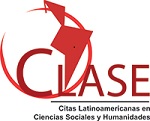The multiplicative impacts of Argentina, Brazil, Colombia, Costa Rica, Chile, Mexico, and Peru on the intra-industry trade in manufactures, 1995-2011
Resumen
The objective of this work is to measure the backward, forward, and total multiplicative impacts of Argentina, Brazil, Colombia, Costa Rica, Chile, Mexico, and Peru on the Global Value Chains of manufacturing exports. By viewing the intra-industry trade in manufactures as an input-output system, we measure their multiplicative impacts from 1995 to 2011. Our results show that the multiplicative impacts of these Latin American countries are very weak. The reason is that the backward multiplicative impacts are bigger than the forward multiplicative impacts; in this sense, the quality level of their manufacturing exports is low.
Texto completo:
PDFReferencias
Chenery, H. B. (1980). “Interactions Between Industrialization and Exports”, American Economic Review, Vol. 70, No. 2.
Ferrarini, B. (2013). “Vertical Trade Maps”, Asian Economic Journal, 27(2). DOI: 10.1111/asej.12005
Ferrarini, B. (2011). “Mapping Vertical Trade”, Asian Development Bank, Working Paper No 263. June. DOI:10.2139/ssrn.1906493
Gereffi, G. and T. Sturgeon (2009), “Measuring success in the global economy: international trade, industrial upgrading, and business function outsourcing in global value chains”, Transnational Corporations 18(2), 1-35. DOI: 10.18356/64e03043-en
Gereffi, G. and K. Fernandez-Stark (2011). “Global Value Chain Analysis: A Primer”, Center on Globalization, Governance & Competitiveness (CGGC), Duke University, North Carolina, USA. http://www.cggc.duke.edu/pdfs/2011-05-31_GVC_analysis_a_primer.pdf
Haussmann, R., J. Hwang, and D. Rodrik (2006). "What you export matters," Journal of Economic Growth, Springer, vol. 12(1), pages 1-25, March.
Hummels, D., J. Ishii, and K-M Yi (2001). “The Nature and Growth of Vertical Specialization in World Trade”, Journal of International Economics, Vol. 54, Issue 1. DOI: 10.1016/S0022-1996(00)00093-3
Kaldor, N. (1968). “Productivity and Growth in Manufacturing Industry: a Reply”, in Kaldor, N., Further Essays on Economic Theory, N. York: Holmes & Meier.
Koopman, R., W. Powers, Z. Wang, and S-J. Wei (2010). “Give Credit Where Credit Is Due: Tracing Value-added in Global Production Chains”, NBER Working Paper Series No. 16426. DOI: 10.3386/w16426
Kowalski, P., J. Lopez Gonzalez, A. Ragoussis, and C. Ugarte (2015). “Participation of Developing Countries in Global Value Chains. Implications for Trade and Trade-Related Policies”, OECD Trade Policy Papers, OECD. DOI: 10.1787/18166873
Maurer, A., and C. Degain. (2010). “Globalization and trade flows: what you see is not what you get!”, WTO, Staff Working Paper N ERSD-2010-12. http://dx.doi.org/10.1142/S1793993312500196
Manufacturing Institute, the Manufacturers Alliance for Productivity and Innovation, and the National Association of Manufacturers (2012). 2012 Facts About Manufacturing, the Manufacturing Institute. http://www.themanufacturinginstitute.org/~/media/1242121E7A4F45D68C2A4586540703A5/2012_Facts_About_Manufacturing___Full_Version___High_Res.pdf
OECD/ECLAC/CAF (2015). Latin American Economic Outlook 2016: Towards a New Partnership with China, OECD Publishing, Paris. http://dx.doi.org/10.1787/9789264246218-en
OECD/WTO (2017)."Trade in value-added", OECD-WTO: Statistics on Trade in Value-added (database). DOI: http://dx.doi.org/10.1787/data-00648-en
Enlaces refback
- No hay ningún enlace refback.


















